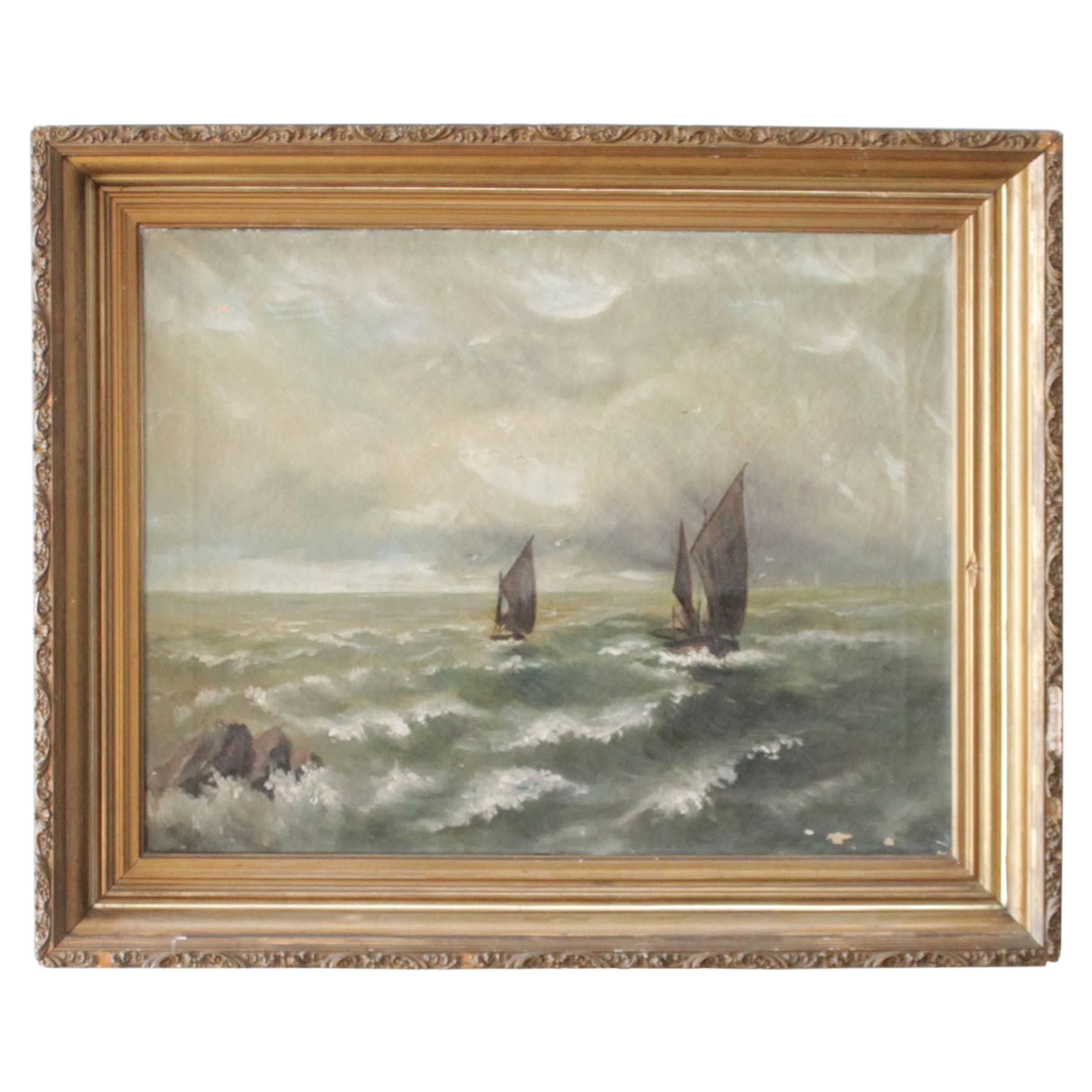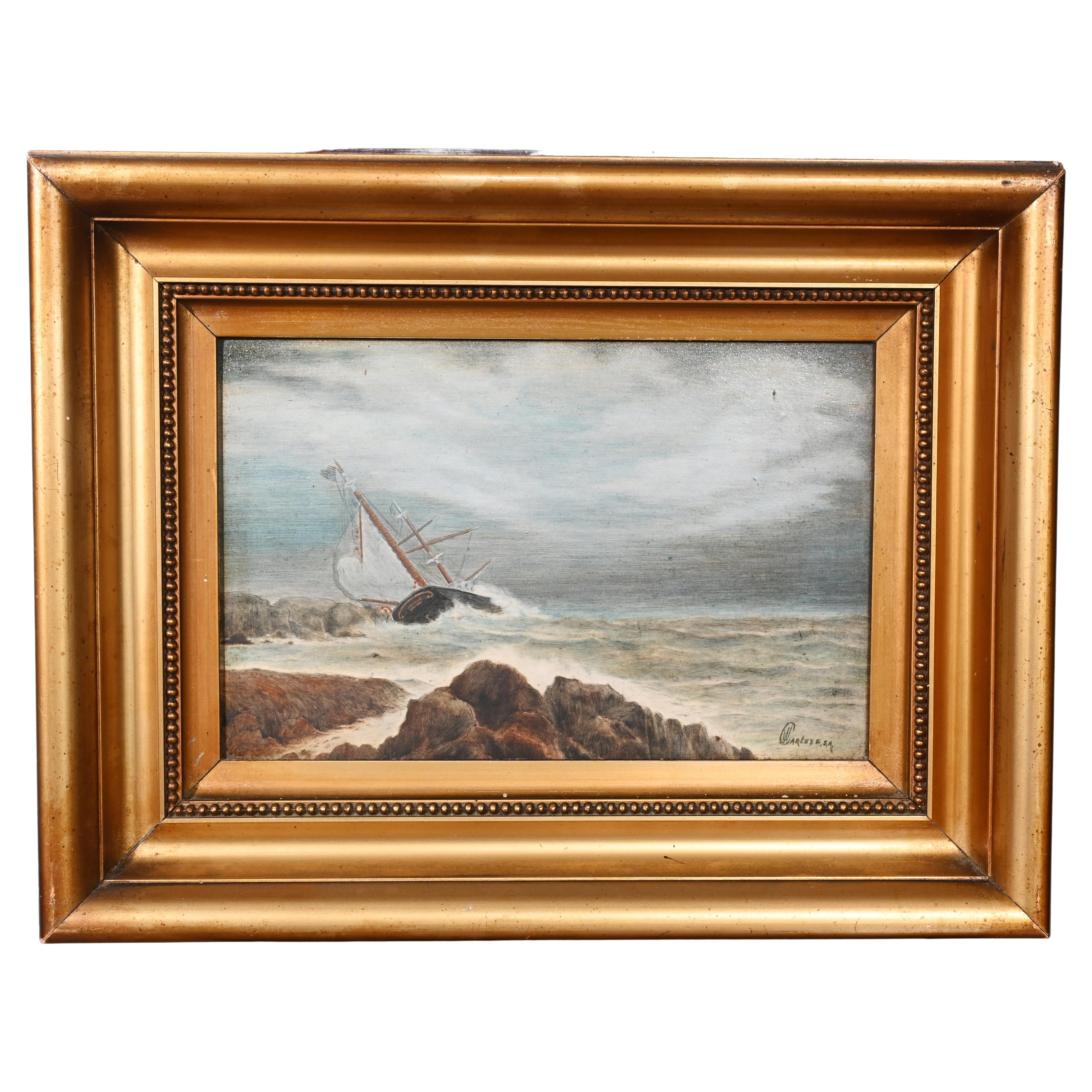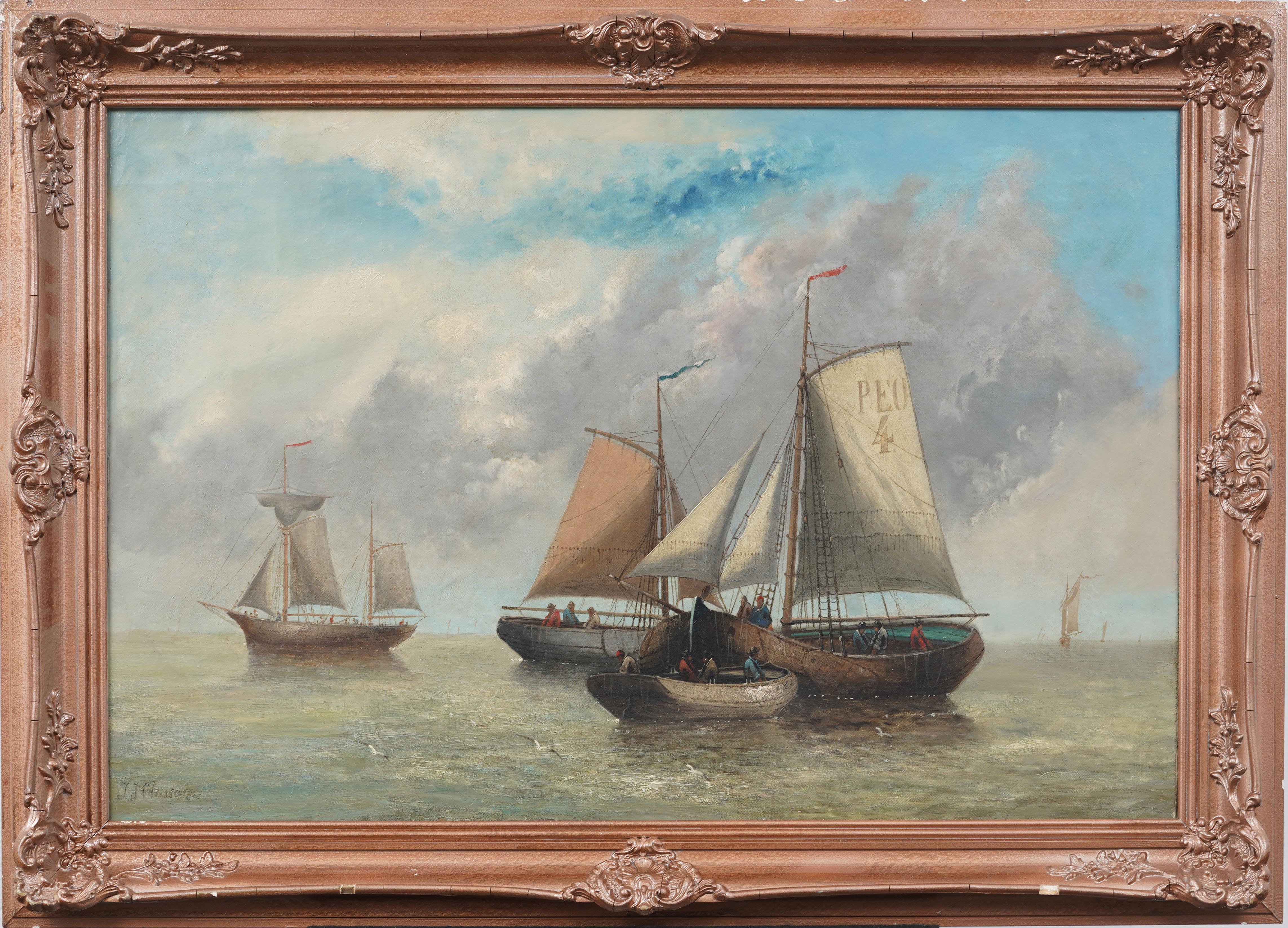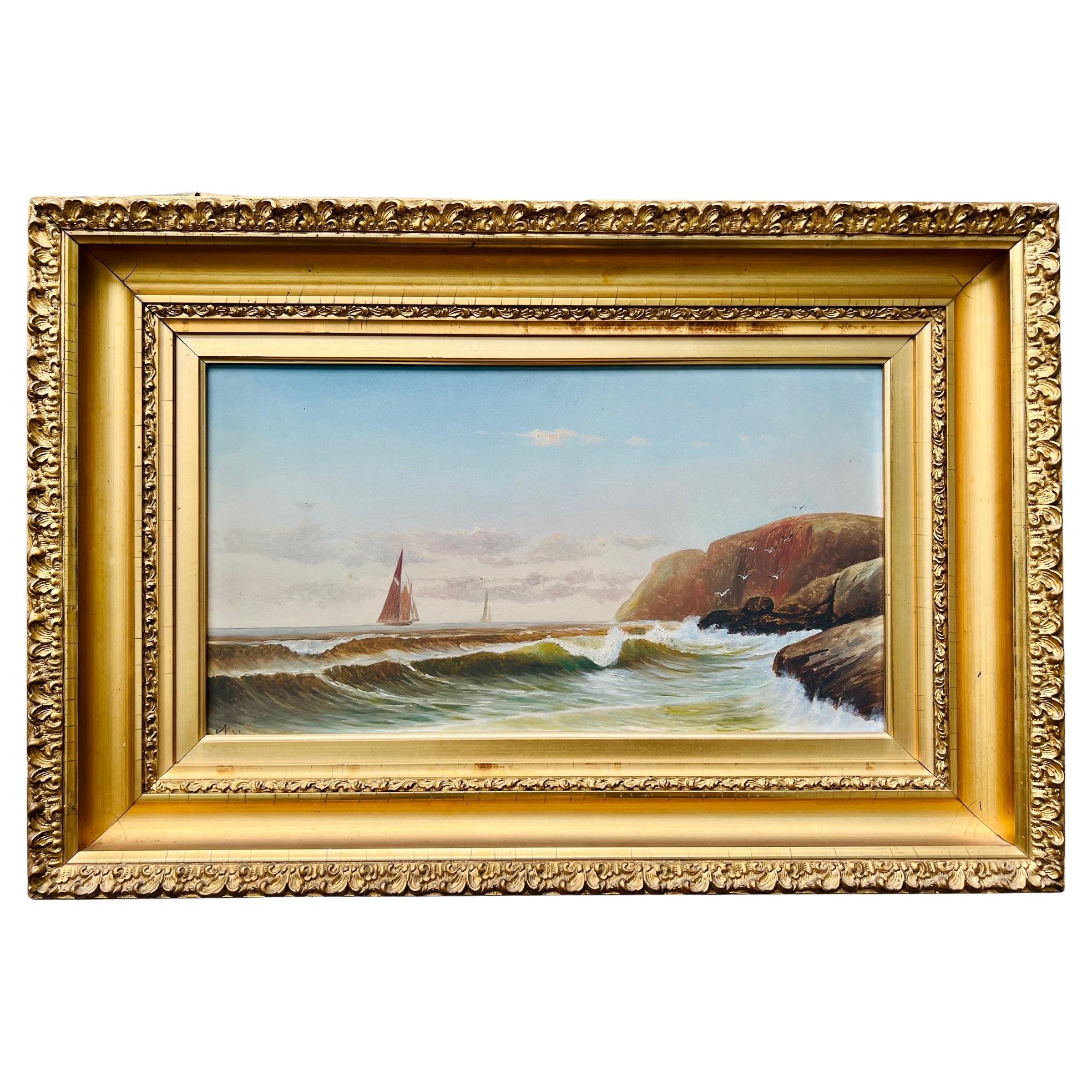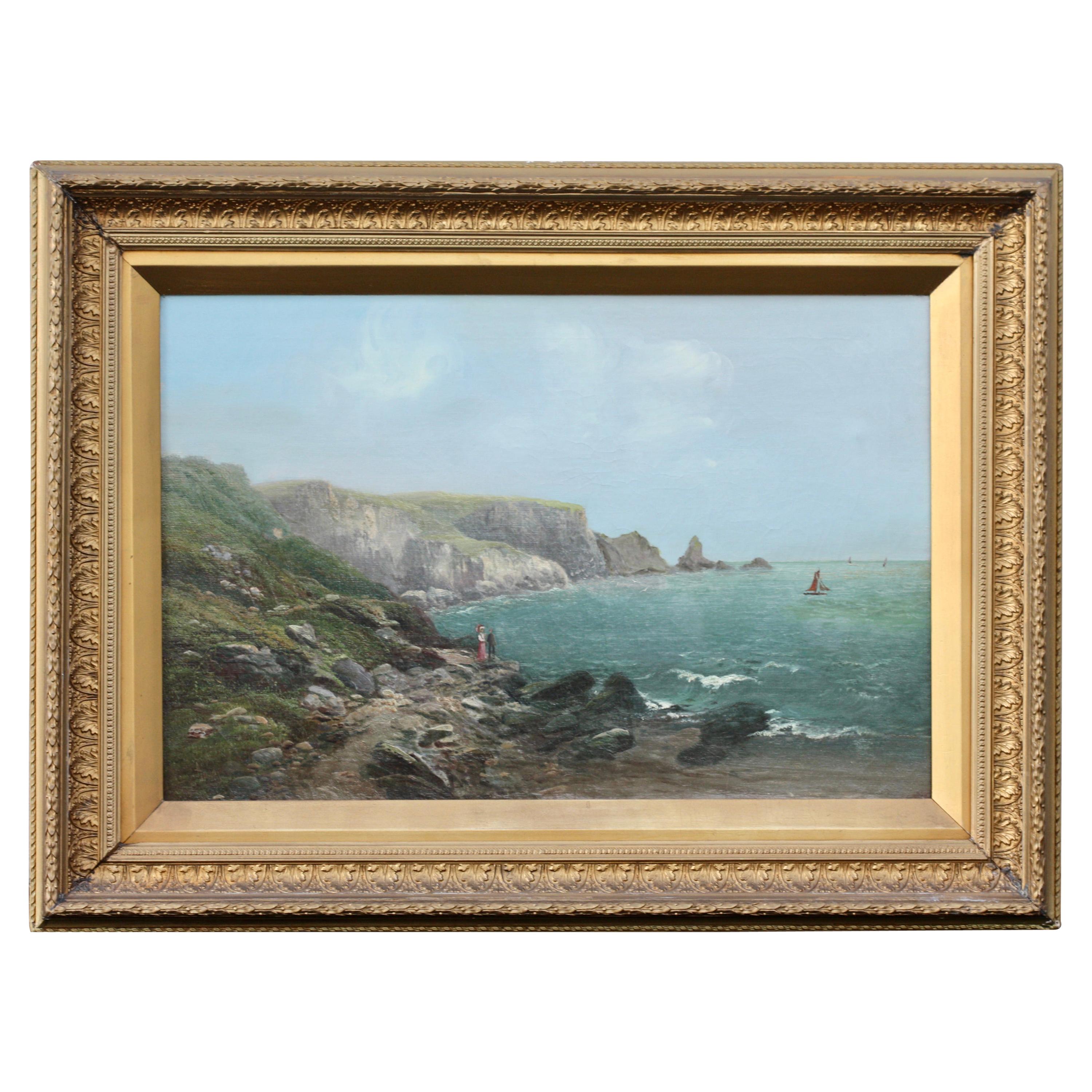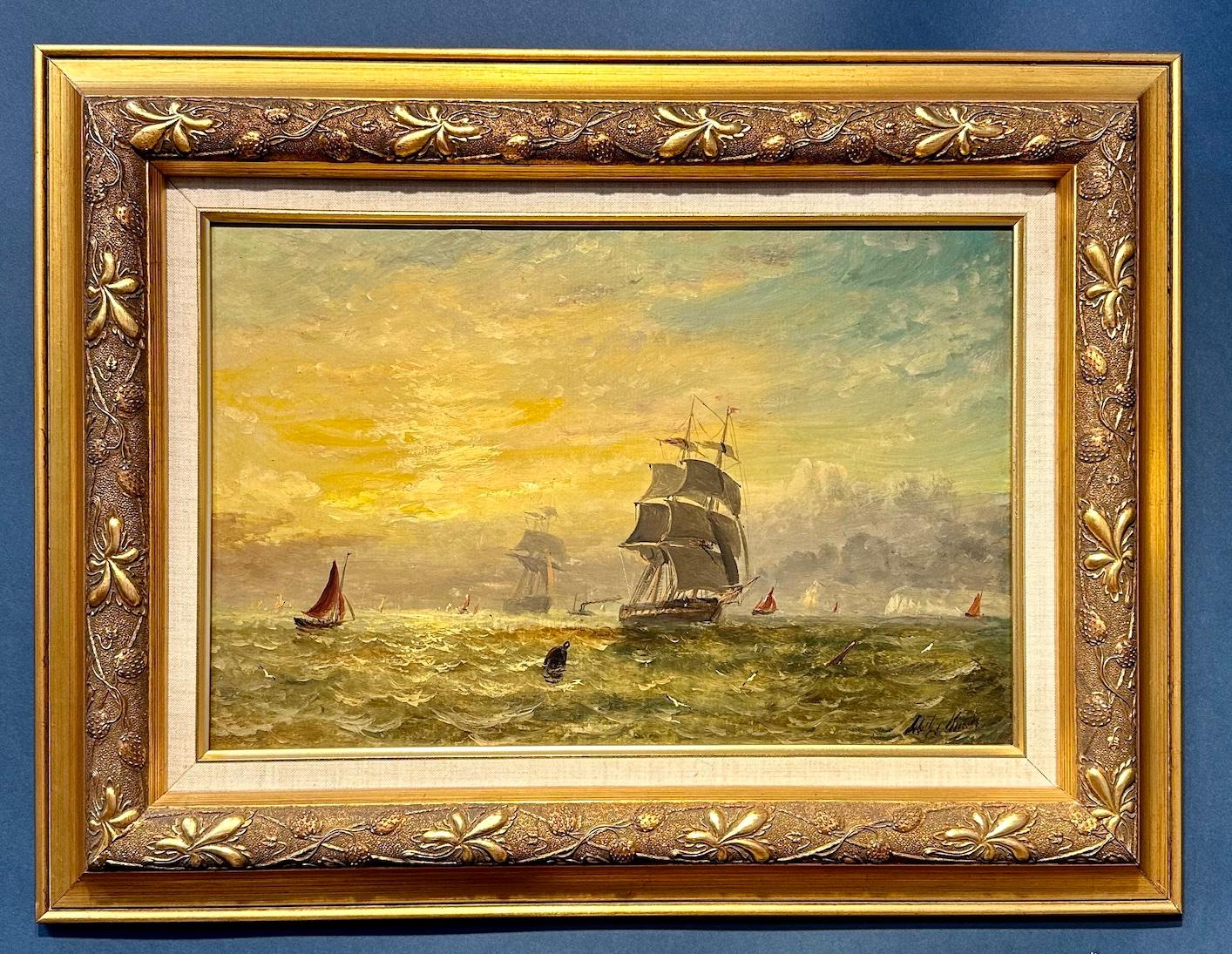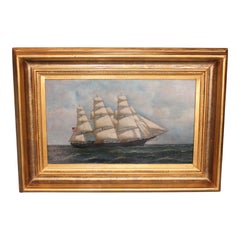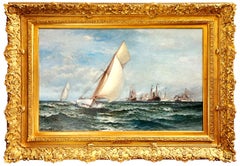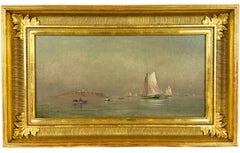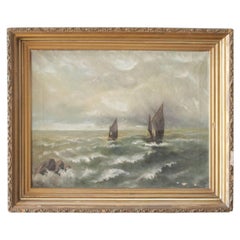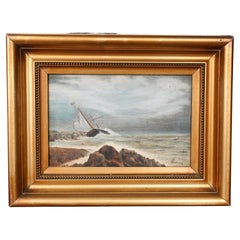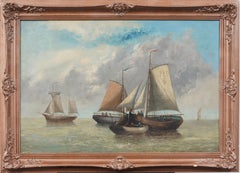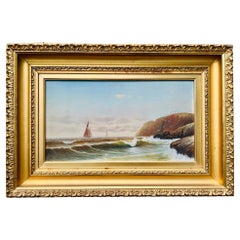Items Similar to Seafaring Tranquility: A Pre-Raphaelite Scene Oil Painting on Canvas, Signed
Want more images or videos?
Request additional images or videos from the seller
1 of 14
John BrettSeafaring Tranquility: A Pre-Raphaelite Scene Oil Painting on Canvas, SignedCirca 1860
Circa 1860
$2,800
£2,121.53
€2,434.29
CA$3,940.05
A$4,331.20
CHF 2,276.28
MX$52,596.56
NOK 28,396.03
SEK 26,903.24
DKK 18,167.71
About the Item
The painting by John Brett, dating back to circa 1860, is a testament to his artistic prowess within the Pre-Raphaelite movement. Meticulously executed on an Antique Oil On Canvas, the artwork conveys a serene and evocative scene. The frame's dimensions are Width: 22.40″ x Height: 16.75″ with a substantial thickness of 3″, encompassing a picture size of Width: 18″ x Height: 12″.
This exquisite painting captures the essence of a cloudy day at sea, seamlessly blending a beach adorned with rugged rocks and gently rolling hills. Commanding the composition is a grand ship, accompanied by a fleet of smaller boats, while birds gracefully populate the skies above. The hues of the grass subtly hint at the season of fall, infusing the scene with a distinct temporal and atmospheric quality. Brett's hallmark meticulous attention to detail and expert handling of nature's nuances are prominently displayed, further showcasing his mastery of the landscape genre within the Pre-Raphaelite movement.
The painting bears the distinct signature of John Brett, affirming his personal involvement and dedication to the artwork. This signature not only adds an intimate connection to the artist but also serves as a testament to the historical and artistic provenance of the piece, unequivocally linking it to the accomplished artist.
In sum, the circa 1860 painting by John Brett stands as a testament to his artistic prowess. With its serene and masterfully rendered composition, it captures the viewer's imagination through its evocative depiction of a cloudy coastal scene. The meticulous attention to detail, skilled use of color, and the artist's distinctive touch combine to create a work that exemplifies Pre-Raphaelite excellence.
John Brett ARA (8 December 1831 – 7 January 1902) was a prominent British artist associated with the Pre-Raphaelite movement, renowned for his meticulously detailed landscapes. Born near Reigate, Brett's artistic talent was nurtured within a creative family; his sister, Rosa Brett, also pursued an artistic career, and they shared a studio during the early 1850s. Brett's early artistic education involved learning from landscape painter James Duffield Harding and Richard Redgrave. His artistic philosophy, however, was significantly influenced by the ideas of John Ruskin and William Holman Hunt, whom he encountered through his friendship with poet Coventry Patmore.
Embracing Hunt's concept of scientific landscape painting, Brett embarked on a journey to Switzerland, where he produced topographical landscapes and absorbed the influence of John William Inchbold. In 1858, he unveiled "The Stonebreaker," a masterpiece that garnered him recognition. This painting featured a youth breaking stones to pave a road in a vividly illuminated and finely detailed landscape. This precision in geological and botanical representation captivated John Ruskin, who predicted that Brett could create a masterpiece by capturing the Val d'Aosta in Italy. Encouraged by Ruskin's support, Brett visited the location, resulting in the 1859 exhibit of his work that was hailed by Ruskin himself.
Brett's oeuvre primarily focused on intricately detailed landscapes, often imbued with scientific accuracy and enriched by moral and religious undertones, in accordance with Ruskin's recommendations. Throughout the 1860s, Brett frequently sojourned in Italy, refining his skill in meticulously capturing nature's intricacies. As he matured as an artist, he expanded his subjects to include coastal scenes and seascapes, which were informed by his ownership of a 210-ton schooner named Viking, allowing him to explore the Mediterranean.
During the 1880s, Brett rented Newport Castle in Pembrokeshire during the summers. This provided a base for his family while he documented the Welsh south and west coasts through painting, sketching, and photography. The National Museum of Wales held an exhibition in 2001 titled "John Brett - a Pre-Raphaelite on the Shores of Wales," showcasing many of his major works from this period.
Brett's interests extended beyond art. He was an avid astronomer from childhood and became a Fellow of the Royal Astronomical Society in 1871. He was also a founding member of the Art Workers' Guild and was elected Master in 1890.
Marine / Maritime painting
27643-LU2595212899582
- Creator:John Brett
- Creation Year:Circa 1860
- Dimensions:Height: 12 in (30.48 cm)Width: 18 in (45.72 cm)
- Medium:
- Period:
- Condition:There is a minor damage on the upper middle part of the painting. Our experts can repair it, with the cost covered by the customer. Feel free to contact us if you need assistance with the repair process. We're here to help ensure the p.
- Gallery Location:Jacksonville, FL
- Reference Number:Seller: 276431stDibs: LU2595212899582
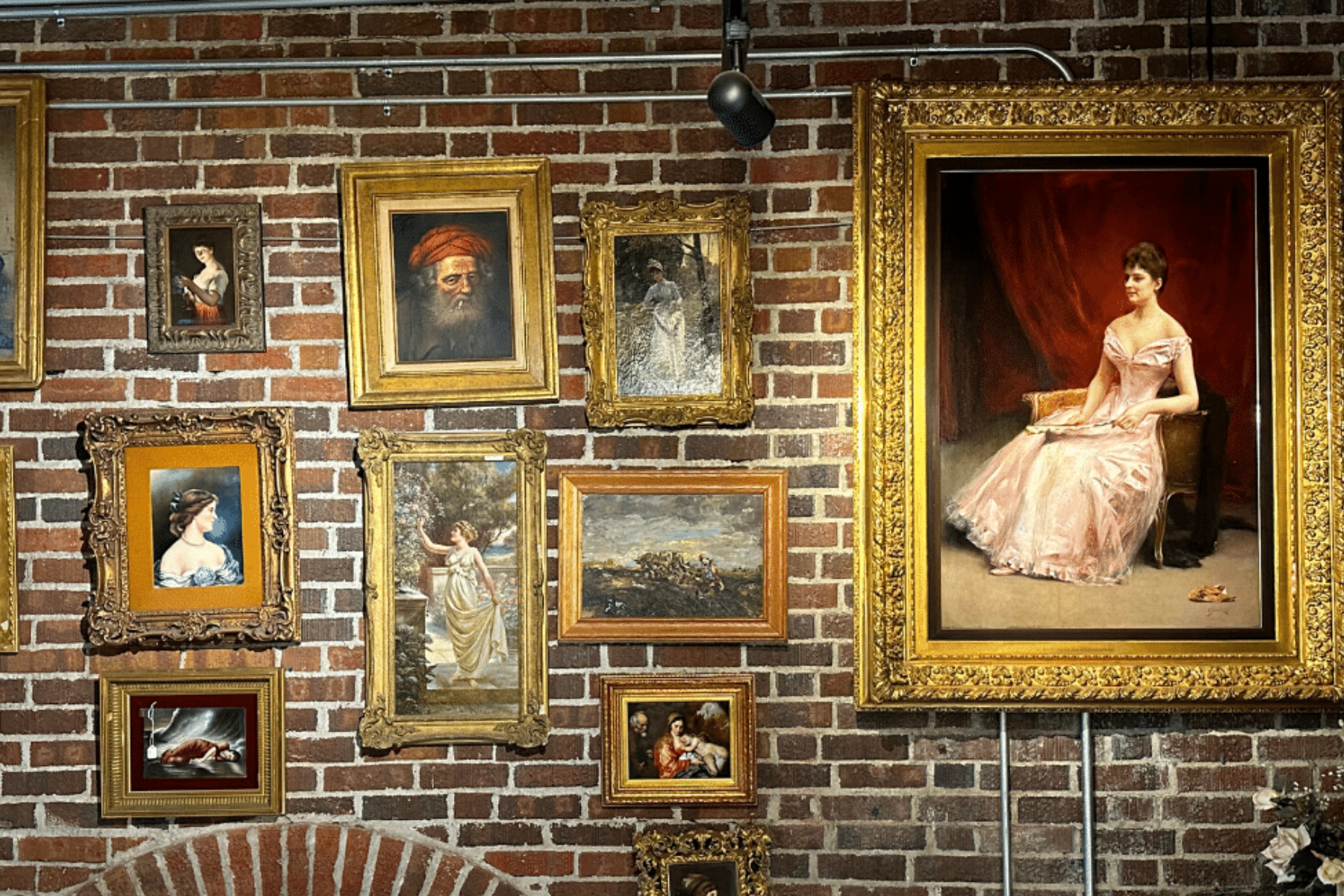
About the Seller
No Reviews Yet
Vetted Professional Seller
Every seller passes strict standards for authenticity and reliability
Established in 1960
1stDibs seller since 2023
17 sales on 1stDibs
Typical response time: 1 hour
- ShippingRetrieving quote...Shipping from: Jacksonville, FL
- Return Policy
Authenticity Guarantee
In the unlikely event there’s an issue with an item’s authenticity, contact us within 1 year for a full refund. DetailsMoney-Back Guarantee
If your item is not as described, is damaged in transit, or does not arrive, contact us within 7 days for a full refund. Details24-Hour Cancellation
You have a 24-hour grace period in which to reconsider your purchase, with no questions asked.Vetted Professional Sellers
Our world-class sellers must adhere to strict standards for service and quality, maintaining the integrity of our listings.Price-Match Guarantee
If you find that a seller listed the same item for a lower price elsewhere, we’ll match it.Trusted Global Delivery
Our best-in-class carrier network provides specialized shipping options worldwide, including custom delivery.More From This Seller
View AllAmerican Clipper Ship at Sea by Antonio Jacobsen, Signed and Dated 1917
By Antonio Jacobsen
Located in Jacksonville, FL
American Clipper Ship at Sea by Antonio Jacobsen, Signed and Dated 1917
This stunning maritime oil painting by renowned marine artist Antonio Jacobsen (1850–1921) captures a majesti...
Category
Early 20th Century American Realist Landscape Paintings
Materials
Oil
The Winning Yacht
By Edward Moran
Located in Jacksonville, FL
"The Winning Yacht," painted by Edward Moran in 1883, stands as a striking example of maritime art, capturing the exhilaration and beauty of yacht racing in the late 19th century. Mo...
Category
1880s American Realist Landscape Paintings
Materials
Oil, Canvas
"Montauk Point Lighthouse" Antique 19th Century Academic Oil Painting on Canvas
By Francis Augustus Silva
Located in Jacksonville, FL
Signed lower left corner
Painting Size: 9.13″ x 18.20″
Frame Size: 14.13″ x 20.13″
Francis Augustus Silva (1835-1886) was a prominent American artist renowned for his remarkable ability to paint boats and seascapes...
Category
19th Century Academic Landscape Paintings
Materials
Oil, Canvas
At the Shore, Victor Huguet, 19th Century Orientalist Landscape , Oil on Canvas
By Victor Pierre Huguet
Located in Jacksonville, FL
With an expert command of light and movement, Victor Huguet’s At the Shore transports the viewer to a coastal expanse where a group of Arab horsemen and figures gather against a stun...
Category
Mid-19th Century Romantic Landscape Paintings
Materials
Oil
Brigantine At Sea
Located in Jacksonville, FL
The painting Brigantine at Sea by William Pierce Stubbs captures the majesty of a two-masted brigantine cutting through the open waters under a v...
Category
Mid-19th Century Landscape Paintings
Materials
Canvas, Oil
“Lake George” by Alfred Thompson Bricher (1837–1908) – Signed. Dated 1867
By Alfred Thompson Bricher
Located in Jacksonville, FL
“Lake George” by Alfred Thompson Bricher (1837–1908) – Oil on Board, Signed & Dated 1867
A luminous and tranquil landscape painting by Alfred Thompson Bricher (American, 1837–1908),...
Category
Late 19th Century American Realist Landscape Paintings
Materials
Watercolor
You May Also Like
Antique Oil Painting of Boat at Sea in Giltwood Frame
Located in Old Town Orange, CA
Antique oil painting of boat at sea in giltwood frame
Unsigned, this oil painting on canvas is framed in a chippy, giltwood frame.
The oil does have age signs with some peeling and...
Category
20th Century Paintings
Materials
Canvas, Giltwood
$1,112 Sale Price
20% Off
Victorian Oil Painting Sea Scape Signed Chales F.S.A 1880
Located in Potters Bar, GB
Wonderful Victorian oil painting in a gilt frame
Classic sea scape or maritime scene
Ship is shown dramatically washed up on the rocks
We date this to circa 1880
Signed Charles F.SA
...
Category
Antique 1880s Victorian Paintings
Materials
Paint
Large Antique Signed Impressionist Nicely Framed Seascape Sailboat Oil Painting
Located in Buffalo, NY
Antique impressionist seascape painting. Oil on canvas. Signed. Framed.
Category
1890s Impressionist Landscape Paintings
Materials
Canvas, Oil
19th Century, American School Nautical Seascape Oil on Board - Signed
Located in Atlanta, GA
American School, 19th century. Signed to lower left but covered by the frame.
This captivating 19th-century oil on board painting, created by an American artist, depicts a vibrant ...
Category
Antique 19th Century American Victorian Paintings
Materials
Wood, Giltwood, Paint
$1,996 Sale Price
20% Off
Continental School, Seascape, Oil on Canvas Gallery Label John Britnell
Located in West Palm Beach, FL
Continental School, 19th century
Seascape, with figures on a beach and a mountainous landscape, illegible signature lower left.
Oil on canvas
with gallery label...
Category
Antique 19th Century Paintings
Materials
Canvas
Antique Victorian, Impressionist 19th century English oil, Fishings boat at Sea
By Adolphus Knell
Located in Woodbury, CT
Antique Victorian, Impressionist 19th century English oil, Fishings boat at Sea.
Adolphus Knell was a superb painter of marine subjects during the middle of the 19th century. His w...
Category
1860s Victorian Figurative Paintings
Materials
Oil, Board
$3,160 Sale Price
20% Off
Free Shipping
More Ways To Browse
19th Century Oil Paintings Religious
Antique Maritime Paintings
Italian Art Antique Painted Religious
Antique Schooner
Rosa Brett
Antique Maritime Paintings
Architecture San Francisco
Cotswold Art
English Countryside Landscape Painting
New England Oil Paintings
St John Paintings
Vermont Painting
Will Howe Foote
19th Century British School
Breton Artists
Country House Paintings
Hastings Antique
Home Sweet Home
